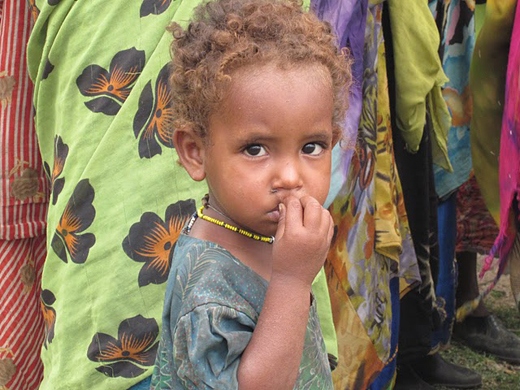
It has been said that Ethiopians’ tolerance for suffering would amaze even the hardest of hearts.
This saying was never more vivid to me than this past June, when I had the opportunity to travel with 11 fellow deacons and priests as a global fellow to Catholic Relief Services aid sites throughout Ethiopia.
After traveling for nearly 20 hours, the first thing that struck me as I left the Addis Ababa airport is that Ethiopia is truly one of the world’s most populated countries. The number of people is staggering. People are everywhere.
Seemingly everyone congregates around the airport — arriving businessmen, returning mothers and children, international aid workers, and 12 deacons and priests who totally stood out as “ferenge” (foreigners).
As we cleared an intense security ring around the airport complex, there were more porters and vendors than I have ever experienced clamoring for my business.
A businessman from the first class section of my flight walked out to meet his SUV ride and another person from the economy class section was met by his donkey cart ride at the same time we met our local CRS representatives.
Immediately we were all besieged by people begging for food, work or money. Never had I felt more overwhelmed and distant from a place I was visiting than I did that evening.
And yet, as the CRS staff member greeted us with a hearty “salaam” (peace), there was a calming presence that we were there for a greater purpose — to learn how to love and serve God through our ministry to all of these people.
It occured to each one of us that as overwhelmed as we felt by the number of people, the people who lived there were overwhelmed much more by the lack of basic needs of food, shelter and clothing.
It became clear to us as CRS global fellows we were charged with somehow taking all of these events in and then coming home to share that message with our fellow Catholics.
CRS provides life-saving aid
We learned that CRS has been working in Ethiopia since 1958. It is one of CRS’ largest country programs, with 123 employees. In fact, CRS Ethiopia implements program activities in nine of Ethiopia’s 10 regions, directly benefiting more than 589,000 Ethiopians without regard to religion or ethnicity.
We also learned that our visit would be severely complicated by the impending famine that Ethiopia was facing. By working closely with local partners, including the Ethiopian Catholic Church, CRS leverages a powerful network across the country that supports service delivery in both urban and rural areas. Key program areas include water and sanitation, emergency preparedness, recovery and agriculture initiatives.
Keeping those goals in mind, we traveled to the far eastern region of Ethiopia (closet to Eretria and Somalia) to learn how those programs created opportunities.
In the lowlands area of Dire Dawa, we saw firsthand young men learning a new trade — bee-keeping — to help provide for their families and communities.
We also learned how important it was to a farmer and his village to receive an ox to help with tilling the rocky soil (with a piece of metal attached to a broken tree branch serving as the plow).
We also visited the highlands area to observe a clean-water project.
Once women spent 80 percent of their day struggling to provide clean water for their families, but now they have a pipeline that brings mountain spring water to their village. In support of our brothers and sisters in East Africa, we Catholics need to pray, learn, share the stories of those in need, advocate on behalf of those who have no voice, and give of our gifts.
Deacon Bill Heiman works for Catholic Senior Services. He also serves at St. Mark and St. Mary in Shakopee, St. Mary of the Purification in Marystown, and Shakopee Area Catholic School and Faith Formation.
About Ethiopia
Ethiopia is landlocked in the Horn of Africa. The country is home to a dense population of 76 million people. Its population is predicted to more than double by 2050.
This population growth spurt will move Ethiopia from the 15th most populous country in the world to the ninth.
More than 75 percent of the population lives on less than $2 per day, and GDP per capita is just over $1,000.
Life expectancy at birth is an average of 56 years.




